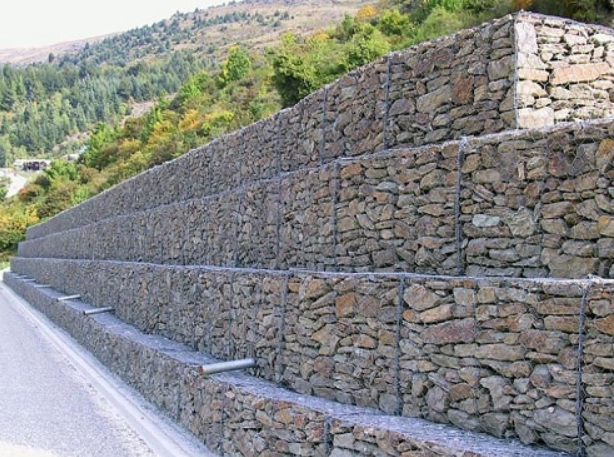The gabions consist of a rectangular “box,” built in the metal mesh of stainless steel or galvanized iron, filled with stones.

These are first placed at the construction site without reinforcement, and after they are in their corresponding place, they are filled with stones, which are then masoned on site and tied to each other, forming a protection structure.
Such a structure has the particularity of its excellent resistance and works in a monolithic form. It is incredibly flexible.

They do not allow the accumulation of stresses due to hydrostatic pressure. By being permeable and allowing water to pass through, they alleviate the significant tensions that accumulate behind the walls. Another particularity of these structures is that they integrate into the environment, allowing vegetation development.

The ability of gabion structures to act as noise barriers should be highlighted, thanks to the voids in the stones, where soil will be deposited and vegetation will develop, excellent for absorbing noise.
They are commonly used in construction, but thanks to their durability and high resistance, different applications have been considered that we are going to mention today.
Uses and applications of gabions

Gabions can be used in various ways, including maintaining unstable slopes, providing erosion control to rivers, canals, and shorelines, creating noise barriers, structural buildings, façade construction, landscape improvement work, and many other applications that require very cost-effective structures. , durable, absorbent, and flexible.
The use of the gabion provides quality to the works since they present a perfect finish: structure without deformations, rectilinear and flat edges, allows the construction of rounded surfaces and the possibility of using them in the filling of numerous materials such as pebbles, stone, wood, bricks. , etc.
Main applications:
- storm defenses
- Protection walls of mountains and towns
- channeling of rivers
- Retaining walls for road fills and embankments
- Stabilization walls and protection of bridge substructures
- marine structures
- slope stabilization
- Storm channeling structures
- Construction of dikes for regularization and correction of towers
- Construction of bridges and footbridges
- Protection and defense of margins, including if environmental integration
Characteristics of the works:
- They do not require a foundation
- terrain adaptation
- easy design
- unskilled labor
- They work by gravity
- flexible
- draining
- quick assembly
- durable
- ecological
Apart from the above, gabions are also used for decorative purposes, which is the latest trend.
